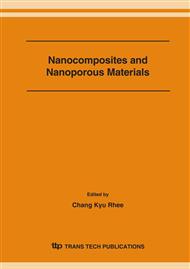p.103
p.107
p.111
p.115
p.119
p.123
p.127
p.131
p.135
Ion Conductivity of Polymer Electrolytes Based on PEO Containing Li Salt and Additive Salt
Abstract:
Solid type polymer electrolyte is in progress of research and development in many ways to improve an ionic conductivity to attain 10-3 S/cm which is possibility of practical use of secondary lithium ion battery. There are two major methods of improving ionic conductivity; either lowering Tg of polymer or lowering the energy of ionic movement. In this work, the solid type polymer electrolyte (SPE) composites, which were composed of poly(ethylene oxide) (PEO), ethylene carbonate (EC) as a plasticizer, lithium salt, and 1-ethyl-3-methylimidazolium hexafluorophosphate (EMI-PF6) as a filler in order to improve the ion conductivity of the SPE, were prepared. The influence of EMI-PF6 contents on the ionic conductivity of the SPE composites was investigated in this work. As a result, the ionic conductivity of the SPE was enhanced by an increase in EMI-PF6 content, and showed the highest ionic conductivity at 40 wt.%. It was thought that there was a close correlation between the mobility of Li+ and EMI content in a SPE composite system.
Info:
Periodical:
Pages:
119-122
Citation:
Online since:
January 2007
Authors:
Price:
Сopyright:
© 2007 Trans Tech Publications Ltd. All Rights Reserved
Share:
Citation:


